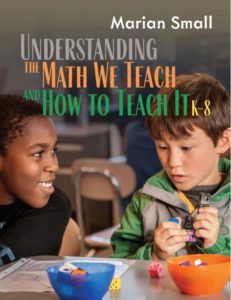A Master Class in How to Teach K-8 Math
Understanding the Math We Teach and How to Teach It (K-8)
By Marian Small
(Stenhouse Publishers, 2019 – Learn more)
Reviewed by Michael Hernandez
I did not know what to expect when I ordered this book. And if I’d had any expectations, I would have been greatly surprised by what I found. This is not a casual, read-in-an-afternoon book. It is more like an encyclopedia (for those under 30, that is what a library of information was called before there was Wikipedia). It’s a master class that’s been bound and printed.
As stated on the back cover, Dr. Marian Small’s 600+ page book (8.5” x 11”) shows how to:
►Focus on the big ideas and practices in mathematics to deepen understanding and content knowledge
►Learn how to teach those big ideas using a student-centered, problem-solving approach
►Anticipate student thinking and explore effective tools, models and rich mathematical questions that nudge student thinking forward.

The remaining 16 chapters progress from Kindergarten through 8th grade. Chapters 5-7 focus on the “Early Number” (sense), “Early Operations” (add, subtract, multiply and divide) and “Developing Fact Fluency” (add/subtract, multiply and divide single digit numbers).
The other 13 chapters cover specific content and skills including larger whole numbers, estimating and calculating, decimals and fractions, ratios and proportions, negative and irrational numbers, data and probability and more.
Each chapter follows the same format. A brief summary “In a Nutshell” and a chapter problem are presented. Then there are discussions, illustrations and activities surrounding the main topic. Each chapter concludes with a list of “Appropriate Children’s Books,” an assessment designed to measure student understanding, some suggestions on how educators can apply what was learned, and a list of selected resources for further study.
Ratio and Proportion
Let’s take a look at one specific chapter, “Ratio and Proportion.” For many of us who teach one or two grade levels, we would skip around to the topics that fit our students. This book, however, shows how topics are frequently taught (informally) through multiple grade levels. I found it very beneficial to discover how students are already being taught to think “proportionally” as early as grades K-2.
For example, through the use of illustrations, stories, tables, graphs, double number lines and more, Marian Small presents many different ways to understand and also to teach rates, ratios, proportions and percents. She also shows how “proportional reasoning plays a significant role in all strands in mathematics” (pg 279).
A valuable long-term resource
I have not finished reading this entire book. I want to first put the things I have learned into action in my classroom. I will return to this book often, especially as I am approaching specific topics in the schedule throughout the school year.
I know this book will prove valuable throughout the remainder of my math teaching career. I am also planning on sharing this book with colleagues. I am sure they will also benefit by the many insights.
Michael Hernandez is an eighth grade Math and Algebra teacher near Akron, Ohio. He has served on the Ohio Math Model Curricula and Content Advisory Committees. He began his career working with middle school, high school and college students. Through the years, he was “promoted” to the point where his time was spent mostly with adults. Now he is back with the young people he loves where he has been teaching for more than 10 years.


































